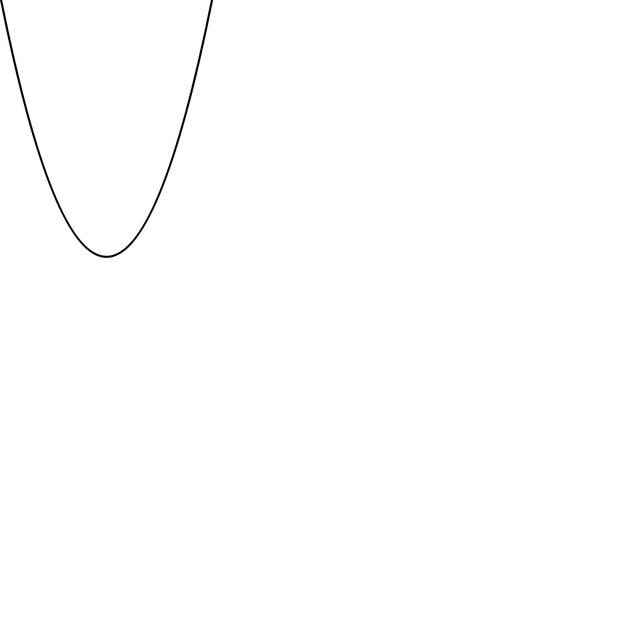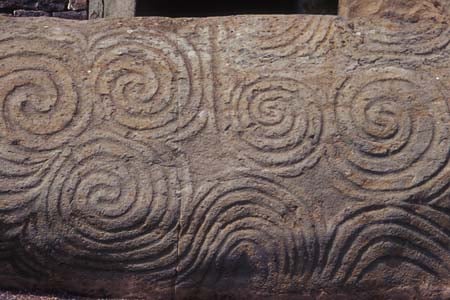Curve

Curve

In mathematics, a curve (also called a curved line in older texts) is, generally speaking, an object similar to a line but that need not be straight. Thus, a curve is a generalization of a line, in that it may be curved.
Intuitively, a curve may be thought as the trace left by a moving point. This is the definition that appeared, more 2000 years, ago in Euclid's Elements: "The [curved] line[1] is […] the first species of quantity, which has only one dimension, namely length, without any width nor depth, and is nothing else than the flow or run of the point which […] will leave from its imaginary moving some vestige in length, exempt of any width."[2]
This definition of a curve has been formalized in modern mathematics as:.
In some context, the function that defines the curve is called a parametrization, and the curve is a parametric curve. In this article, these curves are sometimes called topological curves for distinguishing them from more constrained curves such as differentiable curves. This definition encompasses most curves that are studied in mathematics; notable exceptions are level curves (which are unions of curves and isolated points), and algebraic curves (see below). Level curves and algebraic curves are sometimes called implicit curves, since they are generally defined by implicit equations.
Nevertheless, the class of topological curves is very broad, and contains some curves that do not look as one may expect for a curve, or even cannot been drawn.
This is the case of space-filling curves and fractal curves. For insuring more regularity, the function that defines a curve is often supposed to be differentiable, and the curve is then said a differentiable curve.
A plane algebraic curve is the zero set of a polynomial in two indeterminates. More generally, an algebraic curve is the zero set of a finite set of polynomials, which satisfies the further condition of being an algebraic variety of dimension one. If the coefficients of the polynomials belong to a field k, the curve is said to be defined over k. In the common case of a real algebraic curve, where k is the field of real numbers, an algebraic curve is a finite union of topological curves. When complex zeros are considered, one has a complex algebraic curve, which, from the topologically point of view, is not a curve, but a surface, and is often called a Riemann surface. Although not being curves in the common sense, algebraic curves defined over other fields have been widely studied. In particular, algebraic curves over a finite field are widely used in modern cryptography.
History

Megalithic art from Newgrange showing an early interest in curves

The curves created by slicing a cone (conic sections) were among the curves studied in ancient Greece.

Analytic geometry allowed curves, such as the Folium of Descartes, to be defined using equations instead of geometrical construction.
Interest in curves began long before they were the subject of mathematical study.
This can be seen in numerous examples of their decorative use in art and on everyday objects dating back to prehistoric times.[3] Curves, or at least their graphical representations, are simple to create, for example by a stick in the sand on a beach.
Historically, the term line was used in place of the more modern term curve. Hence the phrases straight line and right line were used to distinguish what are today called lines from curved lines. For example, in Book I of Euclid's Elements, a line is defined as a "breadthless length" (Def. 2), while a straight line is defined as "a line that lies evenly with the points on itself" (Def. 4). Euclid's idea of a line is perhaps clarified by the statement "The extremities of a line are points," (Def. 3).[4] Later commentators further classified lines according to various schemes. For example:[5]
Composite lines (lines forming an angle)
Incomposite lines Determinate (lines that do not extend indefinitely, such as the circle) Indeterminate (lines that extend indefinitely, such as the straight line and the parabola)
The Greek geometers had studied many other kinds of curves. One reason was their interest in solving geometrical problems that could not be solved using standard compass and straightedge construction. These curves include:
The conic sections, deeply studied by Apollonius of Perga
The cissoid of Diocles, studied by Diocles and used as a method to double the cube.[6]
The conchoid of Nicomedes, studied by Nicomedes as a method to both double the cube and to trisect an angle.[7]
The Archimedean spiral, studied by Archimedes as a method to trisect an angle and square the circle.[8]
The spiric sections, sections of tori studied by Perseus as sections of cones had been studied by Apollonius.
A fundamental advance in the theory of curves was the introduction of analytic geometry by René Descartes in the seventeenth century. This enabled a curve to be described using an equation rather than an elaborate geometrical construction. This not only allowed new curves to be defined and studied, but it enabled a formal distinction to be made between algebraic curves curves that can be defined using polynomial equations, and transcendental curves that cannot. Previously, curves had been described as "geometrical" or "mechanical" according to how they were, or supposedly could be, generated.[3]
Conic sections were applied in astronomy by Kepler. Newton also worked on an early example in the calculus of variations. Solutions to variational problems, such as the brachistochrone and tautochrone questions, introduced properties of curves in new ways (in this case, the cycloid). The catenary gets its name as the solution to the problem of a hanging chain, the sort of question that became routinely accessible by means of differential calculus.
In the eighteenth century came the beginnings of the theory of plane algebraic curves, in general.
Newton had studied the cubic curves, in the general description of the real points into 'ovals'. The statement of Bézout's theorem showed a number of aspects which were not directly accessible to the geometry of the time, to do with singular points and complex solutions.
Since the nineteenth century, curve theory is viewed as the special case of dimension one of the theory of manifolds and algebraic varieties. Nevertheless, many questions remain specific to curves, such as space-filling curves, Jordan curve theorem and Hilbert's sixteenth problem.
Topological curve

A dragon curve with a positive area
A simple closed curve is also called a Jordan curve. The Jordan curve theorem states that the set complement in a plane of a Jordan curve consists of two connected components (that is the curve divides the plane in two non-intersecting regions that are both connected).
The definition of a curve includes figures that can hardly be called curves in common usage.
For example, the image of a simple curve can cover a square in the plane (space-filling curve) and thus have a positive area.[11] Fractal curves can have properties that are strange for the common sense. For example, a fractal curve can have a Hausdorff dimension bigger than one (see Koch snowflake) and even a positive area. An example is the dragon curve, which has many other unusual properties.
Differentiable curve
Length of a curve
and then show that
Differential geometry
While the first examples of curves that are met are mostly plane curves (that is, in everyday words, curved lines in two-dimensional space), there are obvious examples such as the helix which exist naturally in three dimensions. The needs of geometry, and also for example classical mechanics are to have a notion of curve in space of any number of dimensions. In general relativity, a world line is a curve in spacetime.
- .
- and
such that the inverse map
Algebraic curve
Algebraic curves are the curves considered in algebraic geometry. A plane algebraic curve is the set of the points of coordinates x, y such that f (x, y) = 0, where f is a polynomial in two variables defined over some field F. One says that the curve is defined over F. Algebraic geometry normally looks not only on points with coordinates in F but on all the points with coordinates in an algebraically closed field K.
If C is a curve defined by a polynomial f with coefficients in F, the curve is said to be defined over F.
In the case of a curve defined over the real numbers, one normally looks on points with complex coordinates. In this case, a point with real coordinates is a real point, and the set of all real points is the real part of the curve. So, it is only the real part of an algebraic curve that can be a topological curve (this is not always the cases, sa the real part of an algebraic curve may be disconnected and contain isolated points). The whole curve, that is the set of its complex point is, from the topological point of view a surface. In particular, the nonsingular complex projective algebraic curves are called Riemann surfaces.
The points of a curve C with coordinates in a field G are said to be rational over G and can be denoted C (G)). When G is the field of the rational numbers, one simply talks of rational points. For example, Fermat's Last Theorem may be restated as: For n > 2, Fermat curve of degree n has a zero coordinate
Algebraic curves can also be space curves, or curves in a space of higher dimension, say n. They are defined as algebraic varieties of dimension one. They may be obtained as the common solutions of at least n–1 polynomial equations in n variables. If n–1 polynomials are sufficient to define a curve in a space of dimension n, the curve is said to be a complete intersection. By eliminating variables (by any tool of elimination theory), an algebraic curve may be projected onto a plane algebraic curve, which however may introduce new singularities such as cusps or double points.
A plane curve may also be completed in a curve in the projective plane: if a curve is defined by a polynomial f of total degree d, then wd (u*/w,* v*/whomogeneous polynomial g(u,* v*,* w*) of degree* d*. The values of* u*,* v*,* wsuch that g* (u,* v*,* w*) = 0 are the homogeneous coordinates of the points of the completion of the curve in the projective plane and the points of the initial curve are those such that* wis not zero. An example is the Fermat curve un*+* vn*=* wn*, which has an affine form* xn*+* y**n* = 1. A similar process of homogenization may be defined for curves in higher dimensional spaces.
Except for lines, the simplest examples of algebraic curves are the conics, which are nonsingular curves of degree two and genus zero. Elliptic curves, which are nonsingular curves of genus one are studied in number theory, and have important applications to cryptography.
See also
Coordinate curve
Curve orientation
Curve sketching
Differential geometry of curves
Gallery of curves
List of curves topics
List of curves
Osculating circle
Parametric surface
Path (topology)
Position vector
Vector-valued function
Curve fitting
Winding number